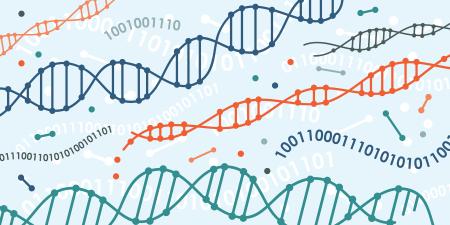In the last 5 years, medical geneticists have been conducting studies to examine possible links between DNA and disease on an unprecedented scale, using newly developed DNA genotyping and sequencing technologies to quickly search the genome. These techniques have also allowed researchers interested in human genetic variation to begin to catalogue the range of genetic similarities and differences that exist across individuals from around the world, through initiatives such as the International Haplotype Mapping Project [1]. These studies of human genetic variation promise to produce new kinds of information about our DNA, but they have also raised ethical questions.
Early results from genome-wide studies of possible links between DNA and various medical conditions are being used by various actors to develop what they call “personalized medicine,” the effort to tailor and individualize diagnoses and treatments for use during routine medical care. The promises of personalized medicine are built on the idea that each individual’s genome is unique. They are also built on the idea that genetic variation among individuals will help explain differential susceptibilities to disease and why some patients respond better to some treatments than others. To this end, researchers have focused on characterizing genetic differences between individuals and groups.
Researchers refer to the genomic sites where these genetic differences occur as SNPs (single nucleotide polymorphisms) and CNVs (copy number variations). These “genetic markers” of human variation are thought to comprise only a tiny proportion, around 0.5 percent, of the roughly 3 billion bases that make up a human genome [2]. Still, many medical genetics researchers are exploring these differences, which they argue may be medically relevant. By genotyping or sequencing the genomes of thousands (and in some cases hundreds of thousands) of individuals, genetics researchers have generated several tools that are being used to dissect the possible contributions of differences in DNA to common diseases. They are also investigating links between genetic variation and differences in patients’ responses to drugs or other medical treatments, a set of practices which has given rise to the field of pharmacogenomics.
As noted above, the basic premise of efforts to develop personalized medicine is that each individual is genetically unique. However, many individuals may have some genetic markers in common, such as a particular genetic variant that might be related to a particular disease. In order to make statistically meaningful assessments, researchers document how often they have observed a particular genetic variant in a particular group of people. One challenge they continue to face is how to select and delineate these particular groups of people, and how to report these genetic “frequencies” in ways that might be meaningful for medical purposes.
Proponents of personalized medicine argue that bringing this new set of practices to the clinic for medical diagnosis and treatment will revolutionize the delivery of health care. But in their efforts to link genetic differences to disease, some researchers claim they can also distinguish other kinds of differences in DNA among people that may or may not be health-related. They argue that these other differences are attributable to membership in different groups defined by race [3, 4] or continental ancestry [5]. These researchers argue that such genetic patterns may have medical importance.
We note two ethical dilemmas posed by the claims made by these and other similar studies that attempt to link genetics, ancestry, and disease, particularly when ancestries are described in terms of continent of origin, for example, European, African, and Asian. Such labels are based on socioculturally defined U.S. categories of race and ethnicity, such as white, black, and Asian. The first dilemma arises because these studies are based on a relatively small subset of individuals who identify within any of these continental ancestry or race groupings. Thus, any extension of study findings to others who identify within these broad groupings would be fraught with problems of accuracy and precision. Indeed, much genetic evidence suggests that those who identify with a particular U.S. race or ethnicity census category are quite genetically heterogeneous [6]. Thus, there is no neat correspondence between genetic variation and one’s assumed race or ethnicity. Indeed, no single pattern of genetic variation is diagnostic of affiliation with any particular race or ethnicity [7].
Second, and consequently, many worry that the new technologies being used to develop personalized medicine may also become technologies that are used to define “genetic signatures” for, or “genetic stereotyping” of, different racial or ethnic groups. This aspect of personalized medicine, if developed and nurtured into broader clinical use, will popularize the idea that it is possible to infer underlying genetic makeup from an observer-defined or self-reported race or ethnicity, when even proponents of using race in genetics research argue that this is a logical fallacy [5]. This possibility recalls some of the past attempts to link race and biology, e.g., the eugenics movements of the early twentieth century.
Indeed, race is not new to medical decision making in the U.S. For decades, it has been common practice among American medical clinicians to use race as one factor among many when deciding among possible diagnoses and treatments. There is a long-standing view in medicine that certain diseases travel more frequently in certain racial groups and a belief that certain groups may respond better (or worse) to certain treatments than others. However, epidemiological evidence of racial differences in disease incidence is not evidence of race-specific genetic susceptibility to disease. Many studies have shown that sociocultural factors that differ by social race categories, including socioeconomic status, contribute significantly to racial differences in disease incidence [8].
Nor is race new to American medical genetics. Many scholars have analyzed the American eugenics movements of the early twentieth century and the more ethically aware field of medical genetics that they eventually gave rise to in the mid-twentieth century [9, 10]. Prior to the start of the Human Genome Project, medical genetics focused primarily on relatively rare, familially inherited diseases. Certain generalizations about the relationships between race and genetics, now part of popular understanding and medical training programs, grew out of these studies. For example, medical school and college biology curricula continue to propagate the idea that some single-gene, highly heritable diseases, like Tay-Sachs disease or sickle-cell anemia, are prevalent in only certain groups—as in Jewish and African American groups, respectively—than other groups. What is often not acknowledged is that Tay-Sachs has also been observed at high prevalence in non-Jewish groups in Quebec, Canada [11] and that sickle-cell and other hemoglobin disorders are common in many groups around the world [12]. The misconception that a particular disease like sickle-cell is specific to African Americans may lead to patients being misdiagnosed or diagnosed too late in the progression of disease simply because they are not of the ethnic group “marked” by the disease.
Just as there are ample counterexamples to these and other generalizations about race and single-gene diseases, so too is the evidence growing against easy links between race and DNA when it comes to the common and complex diseases of current interest in medical genetics. Contemporary medical genetics is using the latest genotyping and whole-genome sequencing tools to explore conditions prevalent in the general population, such as diabetes, heart disease, and asthma, which are not considered to be familial diseases, though they exhibit some heritability. The occurrence of these diseases has long been suspected to be closely tied to one’s environment—factors such as diet, exercise, smoking and drinking habits, air and water quality, standard of living, and so on. Differences in these environmental factors may contribute to differences in disease incidence among different race and ethnic groups, owing not to genetic predispositions but to correlations with socioeconomic disparities that exist between different race and ethnic groups in the U.S. [8].
Indeed, genome-wide studies have not yet been able to find associations between DNA variations and these diseases that are strong enough to explain their apparent heritability [13]. This may provide genetic evidence for previous epidemiological views that these diseases have a high environmental component (which may be “heritable” in its own way through generational inheritance of socioeconomic conditions) and perhaps only a very small genetic component. Finally, to compound matters, recent findings in medical genetics strongly suggest that any genetic contributions to complex diseases have an underlying biology that is much more complicated than can be measured or indicated by the mere presence or absence of genetic markers.
As DNA genotyping and sequencing technologies become faster and cheaper, many actors and institutions are playing prominent roles in efforts to apply these technologies during routine clinical care. The question that remains is, will these new genomics technologies be used to support the idea that differences among individuals, when grouped along racial or ethnic categories, are medically relevant? Many geneticists have shown that categories of race, ethnicity, or “population” as proxies for genetic variation are inaccurate tools for assessing disease risk in medical settings [6]. Similarly, using genetic patterns as readouts of one’s “real” ethnicity or race makes no sense when racial and ethnic groups are social categories constructed within specific historical and cultural situations and not based on genetics. In the U.S., those who identify with any particular census race or ethnic category are far from genetically homogenous, which is not surprising since affiliation in such groups is driven by sociocultural influences. Methods now exist whereby genetic variation may be interrogated at the level of individuals. Why use these methods to redraw lines between racial groups, especially since race groups are not genetic groups, and then use these groups to organize “personalized medicine”? This defeats the aim of personalized medicine, which is to tailor treatment so it is more effective for each individual’s specific combination of health factors.
To return to our first point, many researchers argue that race is a poor proxy for understanding the distribution of human genetic variation. They also argue that genetic variation is not distributed by race, especially not by race defined as continental ancestry. Indeed, most genetic variation occurs within any such groupings rather than between them [6]. However, several direct-to-consumer genetic testing companies sell services that claim to be able to analyze an individual’s DNA and quantify the percentage of their ancestry from each continent and in some cases from regional or tribal groups in Africa.
There are problems with the ways that direct-to-consumer testing companies define continental ancestries. They first select a small subset of present-day individuals whom they judge to be representative of each continent or geographic area, and use the genomes of these people as the reference point for determining which test samples have ancestry from that particular area or tribe [14, 7]. As many commentators have observed, population groups are not and historically have not been discrete, bounded entities, and the definitions used by researchers are neither standardized nor straightforward [15]. Finally, the vast majority of human genetic variation remains unrepresented in genomic databases today—the sample sizes in the databases are exceedingly small and limited to a few individuals who have donated DNA. These databases are too small to build generalizations about different kinds of human groups and their relationship to genetics and disease.
Parsing disease susceptibilities by continental ancestry or race groups and linking these susceptibilities to genetics in medical decision making may have negative consequences for individual health and well-being. For example, the use of race as a proxy for underlying genetic variation could result in misdiagnosis or incorrect treatments for patients assumed to be part of the group(s) with genetic predisposition to the disease in question. Such generalizations may also be detrimental to groups not directly implicated. For example, associations between specific diseases or genetic signatures and particular groups may result in a higher chance that the correct diagnosis of the disease in question will not be made for patients assumed not to be part of these groups.
In addition, many argue that a focus on trying to find genetic differences between race and ethnic groups, in order to explain differences in disease incidence, will distract needed attention and scarce resources away from other more significant factors leading to differential disease susceptibilities among sociocultural groupings, such as quality of life and standard of living, socioeconomic status, neighborhood, and access to health and education.
For these reasons, many medical professionals and scholars are worried about the implications of the use and misuse of race in the new clinical pathways being pursued by advocates of personalized medicine. As many have argued, using race as a lens through which to determine treatment decisions could (and has) opened the door to instances of misdiagnosis or incorrect treatments for individuals [16]. If race becomes the organizing variable for genetic variation, the potentially democratizing new tools of personalized medicine could become instead the instruments of a new means of stereotyping groups of people, legitimized by the perceived authority of genetics.
Personalized medicine is at a crossroads. It may be used to sustain old beliefs about racial differences, yoking them to supposed differences in health and susceptibilities to illness. This in turn may fuel the view that our genetics establishes an innate, definitive roadmap of our future health. However, recent studies of hundreds of common complex diseases suggest that genetics has only a small part to do with our susceptibilities to these diseases.
An alternative route for personalized medicine is for its practitioners to take stock of the various environmental onslaughts that individuals are subjected to and tailor medical diagnoses and treatments by considering each patient’s unique complement of environmental and biological factors that may contribute to health or disease. If personalized medicine is to bear out its name and become truly “personalized,” then a focus on racial differences at the level of the genome constitutes a step off the path with many ramifications, including the possibility of racial and ethnic stereotyping and discrimination during routine medical care that could lead to misdiagnoses and ineffective treatment regimens. Efforts to achieve personalized medicine in clinical settings would do better to focus on patterns in genomes and how such patterns may be associated with disease, rather than trying to find genetic correlates for existing racial and ethnic categories.
Given that the genomics of disease is still in its infancy, the medical relevance of genomics findings remains uncertain. Genomics researchers have a responsibility to be aware of the ways in which they draw boundaries around groups based on genetics, and to communicate the caveats associated with their findings to various publics, other health researchers, medical practitioners, and clinicians. In the push for personalized medicine, such information will be vital in preventing new waves of genetic determinism or new practices of “genetic stereotyping” around disease and race.
Doctors and medical decision makers must also be cognizant of the limitations and caveats associated with findings from genomics studies. Reliable and accurate application of findings from genomics research, particularly when extended to individual patient care, remains for the most part an elusive enterprise, fraught with uncertainty. With regard to decisions relevant to a patient’s health and well-being, the knowledge emerging from genomics is still a long way from being able to reliably inform practitioners about the most effective therapy, treatment or course of action.
References
- International HapMap 3 Consortium, Altshuler DM, Gibbs RA, et al. Integrating common and rare genetic variation in diverse human populations. Nature. 2010;467(7311):52-58.
-
Levy S, Sutton G, Ng PC, et al. The diploid genome sequence of an individual human. PLoS Biol. 2007;5(10):e254.
- Burchard EG, Ziv E, Coyle N, et al. The importance of race and ethnic background in biomedical research and clinical practice. N Engl J Med. 2003;348(12):1170-1175.
-
Risch N, Burchard E, Ziv E, et al. Categorization of humans in biomedical research: genes, race and disease [comment]. Genome Biol. 2002:3(7):2007.
- Via M, Ziv E, Burchard EG. Recent advances of genetic ancestry testing in biomedical research and direct to consumer testing. Clin Genet. 2009;76(3):225-235.
- Rotimi CN, Jorde LB. Ancestry and disease in the age of genomic medicine. N Engl J Med. 2010;363(16):1551-1558.
- Bolnick DA, Fullwiley D, Duster T, et al. The science and business of genetic ancestry testing. Science. 2007;318(5849):399-400.
- Krieger N, Chen JT, Waterman PD, Rehkopf DH, Subramanian SV. Painting a truer picture of US socioeconomic and racial/ethnic health inequalities: the Public Health Disparities Geocoding Project. Am J Public Health. 2005;95(2):312-323.
-
Paul DB. The Politics of Heredity: Essays on Eugenics, Biomedicine, and the Nature-Nurture Debate. Albany, NY: State University of New York Press;1998.
-
Kevles DJ. In the Name of Eugenics: Genetics and the Uses of Human Heredity. Cambridge, MA: Harvard University Press; 1998.
-
Scriver CR. Human genetics: lessons from Quebec populations. Annu Rev Genomics Hum Genet. 2001;2:69-101.
-
Molnar S. Human Variation: Race, Types and Ethnic Groups. 5th ed. Upper Saddle River, NJ: Prentice-Hall; 2003.
- Goldstein DB. Common genetic variation and human traits. N Engl J Med. 2009;360(17):1696-1698.
-
Rajagopalan R, Fujimura JH. Making history via DNA, making DNA from history: deconstructing the race-disease connection in admixture mapping. In: Wailoo K, Lee C, Nelson A, eds. Genetics and the Unsettled Past: The Collision between DNA, Race, and History. New Brunswick, NJ: Rutgers University Press; 2012:143-163.
- Fujimura JH, Duster T, Rajagopalan R. Race, genetics, and disease: questions of evidence, matters of consequence. Soc Stud Sci. 2008;38(5):643-656.
-
Duster T. Backdoor to Eugenics. New York: Routledge; 2003.



